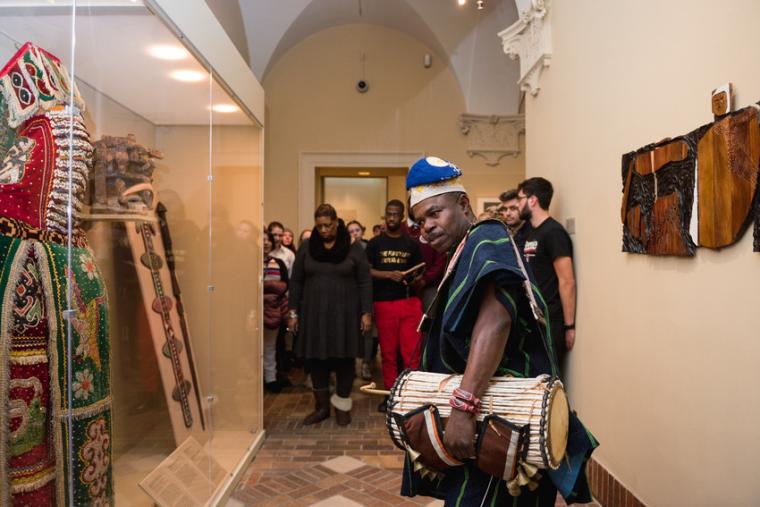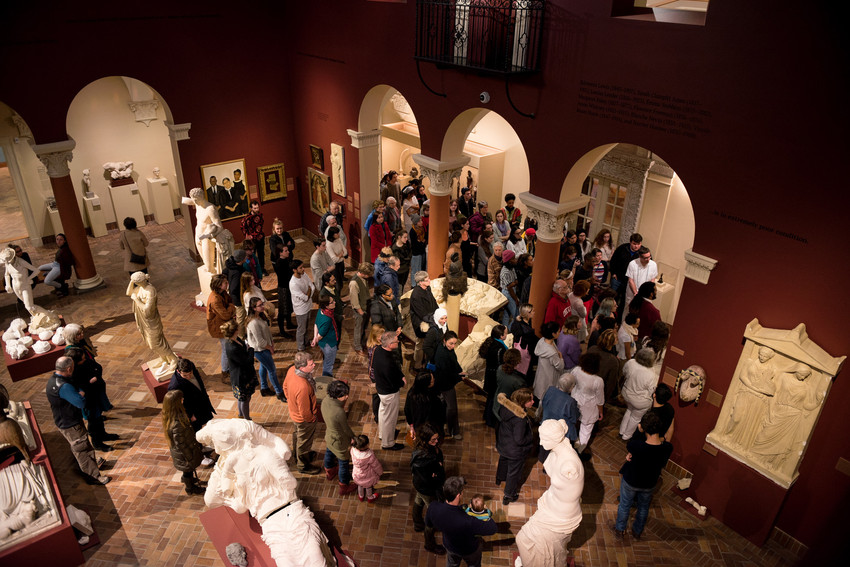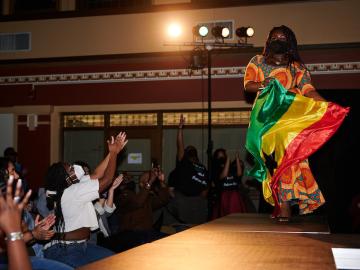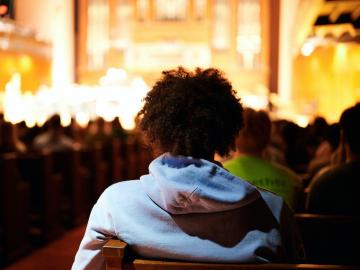Campus News
African Art Gets New Home
February 8, 2017
Hillary Hempstead

Michael Oladipo Oludare stands amid carefully curated objects from the African art collection at the Allen Memorial Art Museum. A large crowd fills the museum’s east ambulatory and its adjoining gallery spaces to witness the official opening of the new African art installation. Oludare, dressed in ceremonial attire, begins drumming a welcome beat on a West African dundun, or “talking drum.”

Welcome ceremonies like these are an uncommon practice at museums, but this was a thoughtfully considered gesture of respect to the objects and their makers. Oberlin College artist in residence Adenike Sharpley emphasized the importance of the welcome. “The objects in this exhibition are usually functional and worn by people. Here, they are out of their setting in a museum. We wanted them to meet their community and be welcomed into it the same as if they were at home.”
The museum has 107 African art objects in its collection. With the opening on February 2, 25 objects are now on view in the ambulatory gallery. The objects are varied and include a selection made by Yorùbá artists, along with pieces such as a three-foot-long carved ivory tusk from Angola and an ivory salt cellar from Sierra Leone. The installation was curated by students in the fall 2016 seminar, African Art in Museums: From Collection to Display, led by Matthew Rarey, assistant professor of the arts of Africa and the black Atlantic. Andria Derstine, John G. W. Cowles Director of the museum, spurred the project.
Derstine approached Rarey in 2016 to discuss curating an installation of African art. But instead of taking on the project by himself, Rarey saw this as an ideal opportunity for students to shape the installation.

“What I wanted to do is make the installation as polyphonic as possible, so I proposed creating this seminar,” said Rarey. “In it, I tried to treat the students as colleagues.” This gave 15 students the freedom to build the exhibition, choose objects for inclusion, create labels, and devise supplementary materials.
“The primary goal for those in the seminar was to build an exhibition that accurately communicates the diversity of African art. “My number one priority was not to portray Africa as a monolith,” emphasized Rarey. “‘Traditional’ African art does not exist. African societies are just as dynamic and varied as those in the rest of the world.”
For aspiring curator and third-year Nia Owen, the seminar allowed her to hone her curatorial skills. “When I first read the course description, I couldn't quite believe it. It seemed like such an incredible opportunity to be given as a student.”
Students met weekly to plan the installation and discuss which 25 objects would be included. “Everyone was given two or three works to research and to see if they were right for this particular exhibition,” explained Leah Newman, a fourth-year art history major and dance minor. “After our individual research, we sat together in the seminar and went through every piece.”
Fourth-year Alexandra Nicome acknowledged that challenges exist in curating an installation with 14 other students. “It’s hard to make decisions with so many other people,” said Nicome, who is also leading a 2:30 p.m. Sunday Object Talk at the Allen during Black History Month. “Sometimes it was contentious, but the group always came to a decision that we were happy with in the end. The readings that Professor Rarey gave us helped us define our criteria and arrive on common ground.”
The group’s aim was to acknowledge the challenges and complexity associated with showing African art in Western art museums. “For the most part, African art was historically never intended to be displayed in a museum, and certainly not a Western one,” said Owen. “In fact, the ideas of ‘artist’ and ‘art’ are vastly different in African cultures in comparison to American culture, so much so that the design of an American art museum, with a strong need to identify artists, dates, and a lot of importance placed on aesthetic value, often creates restraints when attempting to display African art.”
However, being aware of these challenges allowed the students to create an installation that appropriately highlights the objects and encourages conversation among museum visitors.
“Through our many discussions, we knew the story we wanted to tell would highlight many of these issues at hand,” Owen explained. “We wanted to create an exhibition that appreciates the objects and gives them the attention they deserve, challenge the Western concept of art and art-making, and allow the objects to raise questions and provoke discussions on topics such as race, gender, the history of colonialism, slavery, and cultural ownership.”
Tags:
You may also like…
This Week in Photos: Beautiful
March 31, 2022
It’s Saturday night in March and there’s a pulsating glow spilling from the windows of the Root Room in Carnegie Building. Inside, rows of spectators line the perimeter of a long narrow stage. Oberlin’s most anticipated fashion show begins as cheers swell when models, draped in creative attire, take their turn down the walk. This is a signature event during Black History Month. It also serves as inspiration for this week’s photo series.
This Week in Photos: Returns and Openings
October 26, 2021
Silhouettes and attentive audience members facing a bright glow is one photographer’s artistic interpretation of the energy during a concert inside Finney Chapel. The photo also serves as inspiration for this week’s photo series.
Who is Andre Sepetavec?
September 30, 2021
To do the type of work Andre Sepetavec does, one has to be detail oriented with talent as a builder, sculptor, welder, and designer. Knowledge of art history also helps. Learn more about Sepetavec in this installment of Who Am I?


